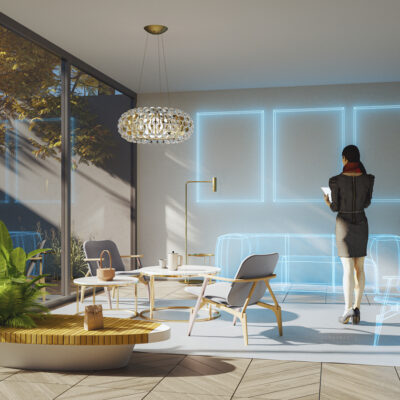It’s 2030 and metaverse is part of everyday life. Going to work in a physical office is already a long forgotten memory. Now you have a work desk at home, from which you join your colleagues in a virtual office.
Last weekend you purchased a vase for your desk to add a little decoration to it. The vase is beautiful and fills you with joy when you look at it.
Too bad you can’t see it in your virtual office. It’s a physical vase, not a virtual one. You could buy a virtual vase for your virtual desk too, but does it make sense to spend twice for the same thing? Of course not!
Once the metaverse is here, you would want to have the ability to teleport arbitrary objects from the real world into your virtual one.
I realized this when I was looking at the patents of one of the most innovative companies in the PC accessory space, Logitech. In one of their patents, they have described technology to bring your physical keyboard into a virtual space. The image below (from the same patent) show how Logitech is envisioning your virtual office might look like:

But that’s just one use case. I think people will want to have virtual access to a lot of items, if not everything they own in real life. Clothes and accessories, for example, are among the foremost things people would want to show off in the virtual world.
For this to happen, you would need a 3D model of the physical object that can be used by your metaverse platform. This is where product manufacturer should take note, because no one can be in a more apt position to supply such a model than the manufacturers themselves.
In fact, whether a product can be ported to the metaverse could become an important factor in influencing a buying decision.
Doing this should not be too difficult technically. Essentially, it would just require a 3D model of the item to be made available on a public cloud, and an RFID tag to be embedded in the product. The VR hardware can then scan the item, download the 3D model from the cloud, and render it appropriately in the virtual world.
Technical issues might arise due to there being multiple multiverse platforms and not just one. So, an open standard for ensuring inter-metaverse object compatibility would definitely be useful here.
It would certainly be that some people might want to bring in items they already own (such as figurines from their collections) into the virtual reality. In such situations, I think 3D scanning apps could come in handy. Such apps can create 3D models from a bunch of picture taken from different angles of, say, a sofa.

Such 3D models will have other uses as well. For one, they will definitely find application on virtual shopping. Imagine being able to put a new dress onto your own 3D model to see how it would look on you, before you buy.
Another exciting use-case would be virtual museums. Most museums have far more artifacts than they can put on display due to space constraints. However, with VR museums, everything can be on display — and your can see it all right from your home — at least for me it’s a super exciting possibility. I wait for the day such virtual reality becomes a real reality.
Liked this article? Subscribe to our newsletter to get more such stuff delivered weekly to your inbox.


